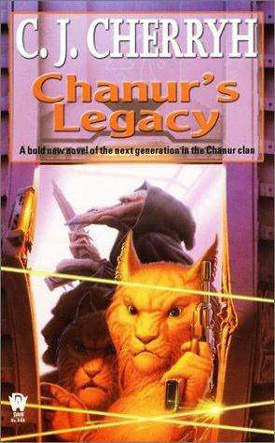 Chanur’s Legacy is a pendant volume to C. J. Cherryh’s great Chanur Saga, possibly one of the most engaging science-fiction series ever written. It’s a new universe — well, partly new.
Chanur’s Legacy is a pendant volume to C. J. Cherryh’s great Chanur Saga, possibly one of the most engaging science-fiction series ever written. It’s a new universe — well, partly new.
The story begins some years after the end of the Saga. Hilfy Chanur is now titular head of the clan, in self-imposed exile from Anuurn as captain of the trading ship Chanur’s Legacy, while her aunt Rhean runs the clan’s planet-side business affairs and her cousin Huran, whom Hilfy despises, is clan Lord. The Chanur have always been, at least in part, free-lancers, and so Hilfy has no hesitation in accepting a commission from the stationmaster of Meetpoint, one No’shto-shti-stlen — well, not much hesitation: the station master is a stsho as slippery as any other, and probably more than most. At any rate, the Legacy will transport an “object” from Meetpoint to the stsho ambassador on Urtur station, for an exceptionally fat fee, a commission which promises to pull the Legacy out of debt and shore up Chanur’s shaky financial base. As a favor, No’shto-shti-stlen asks Hilfy to take with her a crewman abandoned by his ship – itself a problem with major implications: the spacer is hani, is male, he was abandoned by his own ship, and the prejudice against hani males in space displayed by other species is nothing short of breathtaking: all hani males are, by reputation, bloodthirsty and a bit to the left of sane — this notwithstanding the example of Khym nef Mahn, the first man in space and Aunt Pyanfar’s husband.
As we might expect, things are not going to go smoothly. Hilfy is approached by a mahen agent, Tahaisimanid Ana-kehnandian (Haisi, for short), before she has even signed the contract for the stsho commission. And the abandoned spacer – Hallan Meras, whom we met in the epilogue of Chanur’s Homecoming — is a very attractive young man who is just too big for a ship built for women; he is also very polite, very innocent, and very anxious not to be returned to his ship: he wants to be a spacer and he wants to stay with Chanur. (He is a reprise in many ways of Brutus from Legions of Hell and Tristen from the Fortress trilogy, which is a character type that Cherryh seems to find very attractive and one with which she has much success.) And of course, everyone thinks that Hilfy is in close contact Pyanfar Chanur, who is, as we remember from the Saga, now the President of the hani amphictiony of space, the mekt-hakkikt of the kif, the Personage of Personages of the mahendo’sat. Unfortunately, in spite of the general perception, they don’t speak.
Needless to say, when the Legacy reaches Urtur, the stsho ambassador has fled. Since her contract requires that the item be delivered to the ambassador and no one else, the Legacy has to follow.
Chanur’s Legacy what we have come to expect from Cherryh novel: packed with intrigue, layers of deception, plot twists, red herrings, and a few additional complications, including the t’ca, chi, and knnn, methane breathers with unknown, and unknowable, motivations. We don’t know until the crisis just who the villains are – the mahendo’sat are traditionally allied to the hani, the kif are traditional enemies, especially to Hilfy, but Haisi is just a little too greasy and little too uninformative, while the kif Vikktakkht is as subtle and sinister as kif always are, but seems (seems!) to be working with Chanur – this time.
Cherryh is one of the masters of universe-building, and Legacy makes full use of the universe she created for the Saga. In line with the basic tenets of science fiction, Cherryh has filled in the gaps to present a realistic picture of interstellar trade and how it works, and the workings of the various alien societies. Her alien characters are, somehow, eminently believable. She knows how to tell a gripping adventure story, none better. She has, however, set up a couple of things that hurt the novel. Cherryh is not a comic writer; this is not to say her books are humorless, but she seems to work best with a kind of understated situational humor built on character. In this case, the stsho become a major comic element, and, while it has potential, it just doesn’t work on any but the most superficial level. The other major flaw is that she continues a tendency that appeared in the Chanur Saga, and becomes more ond more prevalent in her subsequent novels: rampant introspection. It has its place: it works in the Chanur Saga because it is largely concerned with advancing the story, but it starts to get out of control in the Fortress series and the atevi novels, and almost completely buries Hammerfall — it’s the sort of thing that might be useful in developing character, but quite honestly, Cherryh has a real gift for characterization and the added frills really aren’t necessary. In Chanur’s Legacy, it seriously detracts from the story and does not serve to build any psychological depth in Hilfy’s character (which, when all is said and done, is probably the third major flaw: she’s not particularly believable, just bad-tempered).
While Chanur’s Legacy is a good read, it’s something of a disappointment coming as a sequel to the Chanur Saga. And a note: Chanur’s Homecoming and Chanur’s Legacy have been issued in an omnibus edition (which actually makes a sort of sense) titled Chanur’s Endgame. There. Now you know.
(DAW Books, 1993)
